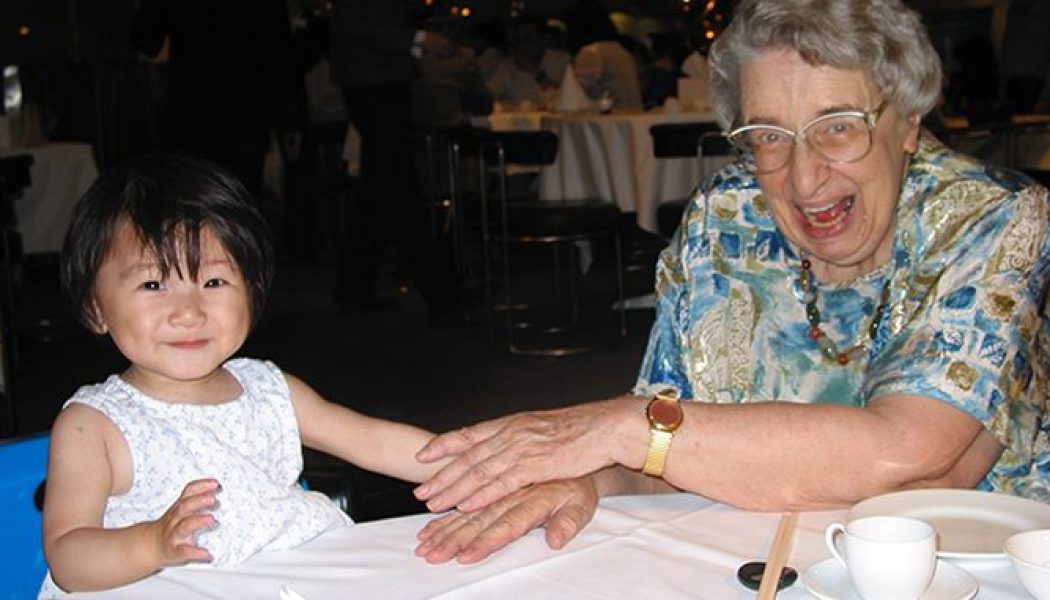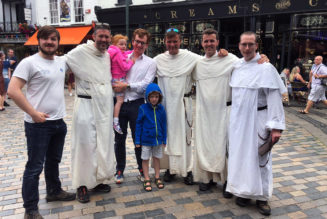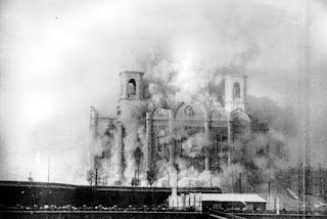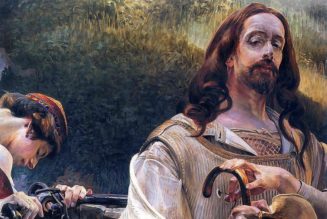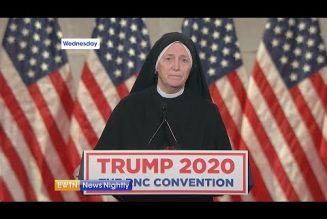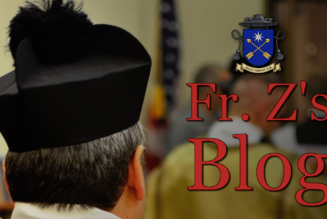
The first two sentences of Audrey Donnithorne’s autobiography, China in Life’s Foreground, suggest something of her character, independence of mind, and dry sense of humor:
I am an Overseas Brit and a Sichuan country girl. My grandparents were born on three different continents, but all were intensely British, especially, perhaps, the duskier among them.
Born on November 27, 1922, at a Quaker mission hospital in rural China, the self-styled “Sichuan country girl” died in Hong Kong on June 8. In ninety-seven years of an extraordinary life, Audrey Donnithorne navigated a kaleidoscope of experiences that rank her as one of the most remarkable Catholics of modern times and a genuine heroine of the faith.
Her Anglican missionary parents traced their evangelicalism to the Clapham Sect social reformers and the great William Wilberforce. Kidnapped by bandits as a two-and-a-half year-old child and held captive for weeks with her parents, she experienced the brutal Japanese war in China as a teenager and lived for a time in Chiang Kai-shek’s ramshackle capital, Chongqing (known in those days as Chungking). She left China for wartime Great Britain via a dangerous flight over “the Hump” (the Himalayas), followed by a slow, tedious voyage around the Cape of Good Hope and through the U-boat-infested waters of the Atlantic. While working in military intelligence at the British War Office, she survived the German V-1 buzz bomb attacks on London and converted to Catholicism.
During her studies in economics at Oxford after the war, she heard Monsignor Ronald Knox preach at the university’s Catholic chaplaincy and befriended a chemistry student named Margaret Roberts, better known in later life as Margaret Thatcher. Frustrated with the abstractions of economic theorists, she never took a doctorate; yet her 1967 book, China’s Economic System, remains a definitive work on Maoist economics and continues to draw the respect of serious China scholars. While conducting a seminar at Hebrew University, she found herself in Jerusalem during the Yom Kippur War. Earlier, she had tasted Mao Zedong’s Great Cultural Revolution in Hong Kong and Macau, and her robust wit was evident in her recollection of one Cultural Revolution absurdity: the revolutionary slogan, “Down with Running Dogs,” displayed right next to the Macau Canidrome, the only racetrack for greyhounds in Asia. (In her autobiography, she also noted that another bit of adolescent rhetoric painted on a church, “Down with the Blessed Mother of God,” was “one of the strangest fulfillments of [Mary’s] prophecy that ‘all generations shall call me blessed’.”) She taught at Canberra’s Australian National University for years, and after her retirement from the classroom Down Under she was affiliated with the Center of Asian Studies at the University of Hong Kong.
Audrey Donnithorne was always where things were happening. But whatever the surface similarities between her amazing curriculum vitae and Zelig or Forrest Gump, Audrey was not fiction and Audrey was not accidental. Her life was providential. And the story of her life is the story of a woman of valor, cooperating with divine grace to be what she believed herself vocationally called to be: doing what she could to improve the lives of others. A world-class scholar with a talent for languages and connections, she was also the model of a New Evangelization Catholic long before the term “New Evangelization” became part of the global Catholic vocabulary.
Before being banned from there a decade or so ago, she traveled frequently to mainland China from her Hong Kong home, always looking for ways to help the struggling Chinese Church. A strong advocate of religious freedom for all, she knew that this first of civil rights was essential to a just society. She helped fund the rebuilding or building of churches and the education of seminarians. She worked with Caritas Hong Kong to help post-Cultural Revolution Chinese Catholics start small businesses that could be part of a financial support-system for desperately poor parishes. In her Hong Kong apartment, she and her friends packed up books, missals, breviaries, Bibles, and other religious materials and then dispatched these Catholic CARE packages into the ironically-named People’s Republic of China: food for the souls of the Chinese people she loved with a clear-eyed view of their complex humanity.
Perhaps most importantly, she worked to build bridges of understanding and cooperation between what are often, and simplistically, thought to be China’s deeply and permanently divided “underground Catholics” and “patriotic Catholics.” Knowing the vast differences within China and understanding Chinese culture from the inside, she knew that things are rarely simple or straightforward in the Middle Kingdom. A very practical person, Audrey Donnithorne took situations and personalities one-at-a-time, never trying to force people or circumstances onto some Procrustean bed of theory or ideology. That approach made a real difference. Her hard, patient, and effective work helped bring illicitly ordained Chinese bishops into full communion with the Bishop of Rome during the pontificate of John Paul II – work for which she was awarded the Papal Cross Pro Ecclesia et Pontifice.
At the same time, she understood that the current Chinese leadership under Xi Jinping was bent on creating a “Sino-Catholicism” for its own purposes. And it is scandalous that those now responsible for China in the Vatican seem never to have taken counsel with Audrey Donnithorne, who knew far more about China than any Italian papal diplomat. Perhaps her longstanding collaboration with the redoubtable Cardinal Joseph Zen, SDB, Bishop Emeritus of Hong Kong, branded her a “non-friend” in the Rome of recent years. If so, the losers from that sorry misperception were the architects of today’s Vatican China policy, an ongoing disaster for the Church’s evangelical mission on the mainland.
Toward the end of her 2019 autobiography, which is largely allegro and dolce, she nonetheless penned a sharp-edged reflection on the Holy See’s approach to China today that is worth pondering:
I often wish that the monsignori in the [Vatican] Secretariat of State, instead of spending time and effort on trying to re-establish diplomatic links with the Chinese government, would go out on the streets of Rome and look for any Chinese tourists who seem bewildered and offer to show them around the sights. On one of my last visits to Rome, in the 1990s, I noticed two young Chinese near St. Peter’s, looking puzzled and consulting their guidebook. I went up to them and, after their surprise that I addressed them in Chinese, asked if they would like to be shown around the basilica; they gladly agreed…Let us remember that on the birthday of the Church, when the Holy Spirit descended on that prayerful gathering of believers, their immediate reaction was not to discuss how to deal with Caesar in the imperial capital, but to go out into the streets around them to speak both to the locals and to the visitors from overseas who were thronging the city.
Audrey and I never met in person but, via e-mail and telephone, we became friends and colleagues because of John Paul II.
Although there are fourteen language editions of Witness to Hope, the first volume of my John Paul II biography, the only translations the Pope really urged me to get done were German and Chinese. With strong support from Cardinals Joseph Ratzinger and Joachim Meisner, a German translation and edition were arranged without too much difficulty. Chinese was a different matter. It was obvious that the book could not be produced in the People’s Republic. A Chinese edition of Witness to Hope published on Taiwan would never make it into mainland China, and the whole point of the exercise was for John Paul to be able to “visit” China through the book. So the only serious option was translation and publication in Hong Kong.
Cardinal Zen’s predecessor as bishop of Hong Kong was a rather timid man, whose response to my inquiries was that such a project would be terribly expensive, not commercially viable, and likely inopportune – this, despite the fact that the Pope himself had urged the book’s translation and publication in Chinese. Such reticence disappeared when Joseph Zen became bishop. In the meantime, as I was trying to get done what the Pope wanted done, I “met” Audrey Donnithorne through the good offices of Dr. Grace Goodell of the Johns Hopkins University School of Advanced International Studies and we quickly became e-mail correspondents. I explained the situation, and in her typical, pragmatic way, Audrey took the problem in hand and, with Cardinal Zen, solved it. Funds were found for a translation; a translator was engaged; and at our last dinner on December 15, 2004, I was able to tell John Paul II that a Chinese edition of Witness to Hope would in fact happen.
It took a while, not least because of the challenge of accurately translating a 1,000-page book into a character-based language so that my meaning (and, more importantly, John Paul’s) were precisely conveyed. A week or so before she died, Audrey sent me a brief video, thanking me for my friendship and prayers and apologizing for not having done more to get the Chinese Witness to Hope project completed. That was, of course, not her fault; but it was entirely in character for her to imagine that it was, and that she had somehow failed me. So it was another happy, providential coincidence that, a few days later, Cardinal Zen wrote me with the news that the translation had finally been finished and the presses were ready to run with the long-gestated Chinese edition of Witness to Hope. With the kind assistance of two of Audrey’s longtime friends, William McGurn of the Wall Street Journal and Teresa Lai, wife of the intrepid Hong Kong democracy activist and philanthropist Jimmy Lai, I was able to get word of this to Audrey shortly before her death.
Audrey Donnithorne died with Teresa Lai and the Lais’ daughter Claire praying the rosary with her. Her ashes will be buried in her native Sichuan, at the Church of Our Lady of Lourdes. In the future, after the current Chinese regime and its assault on religious freedom is a bad memory, that church should become a place of pilgrimage. Audrey would scoff at the notion, I’m sure. But she was a true confessor of the faith and, in God’s providence, I trust she will be long be remembered as such.
If you value the news and views Catholic World Report provides, please consider donating to support our efforts. Your contribution will help us continue to make CWR available to all readers worldwide for free, without a subscription. Thank you for your generosity!
Click here for more information on donating to CWR. Click here to sign up for our newsletter.
